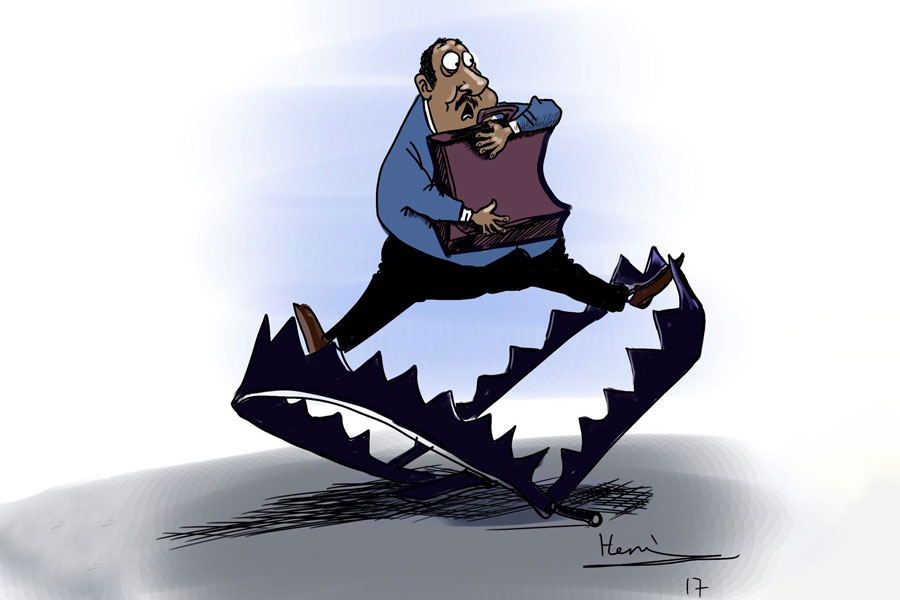
Radar | Aug 20,2024
Sep 10 , 2022
By Yehualashet Tamiru Tegegn
Economists have long proposed austerity policy measures, basing their reasoning on market efficiency. However, economic austerity is more likely to protect the rich than the masses, writes Yehualashet Tamiru Tegegn (yehuala5779@gmail.com), lawyer and researcher. The views and opinions stated in this article are solely those of the author and do not represent the institutions or projects he is affiliated with.
The oft-cited argument for austerity amongst mainstream economists is that it addresses the “crowding out” effect in the economy when government spending, whether financed by taxes or borrowing, will divert resources from productive use by private actors. This argument is not only wieldy supported by the leading academic figures like Adam Smith and David Ricardo but also adopted by various governments.
Austerity is an economic policy born out of the crisis of capitalism. Capitalism mainly works on two fundamental yet related pillars: ownership of means of production by private parties and the wage relationship between the capitalist and the working class.
Austerity policy is yet another means to preserve capitalism and the capital order by diverting resources from the majority to the minority.
Two strategies have been used to enforce this policy: consensus and coercion. The latter, in turn, has three elements, commonly referred to as the austerity trinity: fiscal, monetary and industry.
The first and foremost austerity tool is fiscal policy, which has two faces: expenditure and revenue. The expenditure aspect of fiscal policy is in terms of cutting public funds, especially budget cuts on social endeavours like school, road, health and other sectors. As part of this policy, governments were urged to cut welfare and social expenses to avoid price control over primary goods, unemployment benefits and other acts which increase public expenditures and interfere with the market. The primary purpose of this public budget cut is to use the money for payment of debt that rests in the hands of national or international creditors. Therefore, the resource reverts from the public to the few private parties.
The second aspect of fiscal policy is the revenue aspect, which is achieved through taxation. By imposing taxes, the government is required to perform services that benefit the general public. However, taxes usually target the less well-off sections of society rather than a few wealthy people. The main source of government revenue is income tax rather than profit taxation and, the tax system either in effect or in nature is regressive. The regressive nature of taxes could take various forms.
The first one is the shiftable nature of some taxes. Taxes can be classified as direct and indirect on the basis of the incident. Incidence refers to the economic class that finally bears a tax's monetary burden. In cases of certain taxes, the real taxpayer is different from the one designated by law as such. This is to say that a person may pay a tax without legal obligation to pay. It happens due to an economic fact known as tax shifting.
Consumption tax, for instance, is imposed on consumers but collected from the sellers. Governments intend to tax the consumption expenditure of their subjects but are afraid of the administrative difficulties involved in collecting it from individual consumers. In the end, the buyers pay the actual tax on the product. Consumption tax or indirectly income taxes in general are regressive with regards to the disposable expenditure despite being proportional or even progressive with respect to total expenditure. Taking 15pc VAT from the richest person in the country and a poor person who happened to drink the same coffee in a restaurant is taking very little from the rich and too much from the poor.
Unfortunately, this is not the only negative aspect of indirect taxes. Without the means to adjust the tax liability in relation to the payers’ ability, they are much of a burden to the lower class than well-to-do citizens. This is because the well-to-do spend a smaller portion of their income on consumption compared to the poor.
In the case of direct taxation, one of which is income tax, the incidence and burden of the tax rests on the individual taxpayer and cannot be shifted like indirect taxes. The non-shift-ability nature of income tax induces taxpayers not to comply with the tax laws. As the poor individuals have their income known by the government from their payrolls, chances are high that there is less tax invasion. On the other hand, the few rich people who can afford to hire smart lawyers and accountants always find a way to avoid paying taxes. A recent study by the Institute on Taxation & Economic Policy showed that at least 55 big corporations in the United States paid no income taxes despite enjoying a substantial profit. By doing so, big corporations managed to shift the tax burden from the companies and shareholders to workers’ wages.
Another aspect of taxation that should be noted here is the reduction of corporate income tax. For instance, the United States' top marginal tax rate used to be as high as 91pc during Eisenhower’s presidency and went down to a flat tax rate of 21pc during Trump's administration.
Exemption of inheritance tax could also be cited as a form of regressive taxation since the fortunes accumulated by the capitalist are left untouched. According to a recent study in the OECD, the wealthiest ten percent of households own half of all household wealth on average. Thus, by refraining from taxing this wealth transfer, the system is favouring the rich over the poor.
The second policy is monetary policy, which is related to an increment of interest rate and reduction of money in the market circulation. Increment in interest rate has its own immediate and long-term impacts. The immediate effect is as the interest rate increases, it becomes cumbersome for the government to borrow money which affects its expenditure. Moreover, as the interest rate increases, borrowing will also be costly; hence, consumption will decrease as the working class's disposable income decreases.
For instance, in most countries, people buy their houses through bank loans. As interest rates increase, their repayment also increases. This will decrease consumption. On the other hand, interest increases will induce people to save more and the purchasing power of money increases as money in the market will be scarce. The increased interest rate and economic contraction benefits a few creditors who hold government bonds and financers. Without this policy, there will be high consumption that leads to inflation and hikes the cost of production and wage of the labour cost - these could be seen as a big threat to capital accumulation.
Apart from this immediate impact, monetary policy has two long-term consequences. Increment in interest rates makes borrowing expensive not only for the government and for the general public but also for investors. As investment decreases, unemployment will increase. As unemployment increases, the bargaining power of the labour force will decrease and investors can hire qualified workers for a price much below their worth. Furthermore, as investment decreases, the economy will contract. Government, fearful that capital or investors may relocate, will ultimately decrease the corporate income tax rate.
The third policy is industrial policy which is related to industrial peace. Industrial peace is crucial in securing property rights, and wage and monetary stability in the long run. Industrial policy has much to do with the above two mentioned policies. For instance, as interest rates increase, investment and employment will decline. Those who manage to secure jobs will have every incentive to discipline themselves as they are easily disposable and finding another job will be difficult in such a time. Thus, the political leverage and militancy of labour will be very low and the competition will be high.
If there is high unemployment, labour will be cheaper. As the labour cost declines, one of the main production costs, the selling price of products declines, attracting more buyers and increasing international trade. This and similar measures protect the vertical wage relationship between the capitalist and the workers. It will also ultimately increase the chances of wage repression for the benefit of the capitalist.
When contemporary economists like John Cochrane argued for austerity policy measures, their reasoning was based on market efficiency. However, economic austerity protects very few rich people than the market and the general public.
PUBLISHED ON
Sep 10,2022 [ VOL
23 , NO
1167]


Radar | Aug 20,2024

Films Review | Nov 21,2018

Fortune News | Apr 03,2023

Radar | Nov 16,2024

Editorial | Oct 20,2024

Editorial | Feb 13,2021

Radar | Sep 29,2024

Radar | Dec 08,2024

Radar | Sep 29,2024

Viewpoints | May 11,2023

My Opinion | 131770 Views | Aug 14,2021

My Opinion | 128154 Views | Aug 21,2021

My Opinion | 126099 Views | Sep 10,2021

My Opinion | 123721 Views | Aug 07,2021

Dec 22 , 2024 . By TIZITA SHEWAFERAW
Charged with transforming colossal state-owned enterprises into modern and competitiv...

Aug 18 , 2024 . By AKSAH ITALO
Although predictable Yonas Zerihun's job in the ride-hailing service is not immune to...

Jul 28 , 2024 . By TIZITA SHEWAFERAW
Unhabitual, perhaps too many, Samuel Gebreyohannes, 38, used to occasionally enjoy a couple of beers at breakfast. However, he recently swit...

Jul 13 , 2024 . By AKSAH ITALO
Investors who rely on tractors, trucks, and field vehicles for commuting, transporting commodities, and f...

Jul 5 , 2025
Six years ago, Ethiopia was the darling of international liberal commentators. A year...

Jun 28 , 2025
Meseret Damtie, the assertive auditor general, has never been shy about naming names...

Jun 21 , 2025
A well-worn adage says, “Budget is not destiny, but it is direction.” Examining t...

Jun 14 , 2025
Yet again, the Horn of Africa is bracing for trouble. A region already frayed by wars...

Jul 6 , 2025 . By BEZAWIT HULUAGER
The federal legislature gave Prime Minister Abiy Ahmed (PhD) what he wanted: a 1.9 tr...

Jul 6 , 2025 . By YITBAREK GETACHEW
In a city rising skyward at breakneck speed, a reckoning has arrived. Authorities in...

Jul 6 , 2025 . By NAHOM AYELE
A landmark directive from the Ministry of Finance signals a paradigm shift in the cou...

Jul 6 , 2025 . By NAHOM AYELE
Awash Bank has announced plans to establish a dedicated investment banking subsidiary...